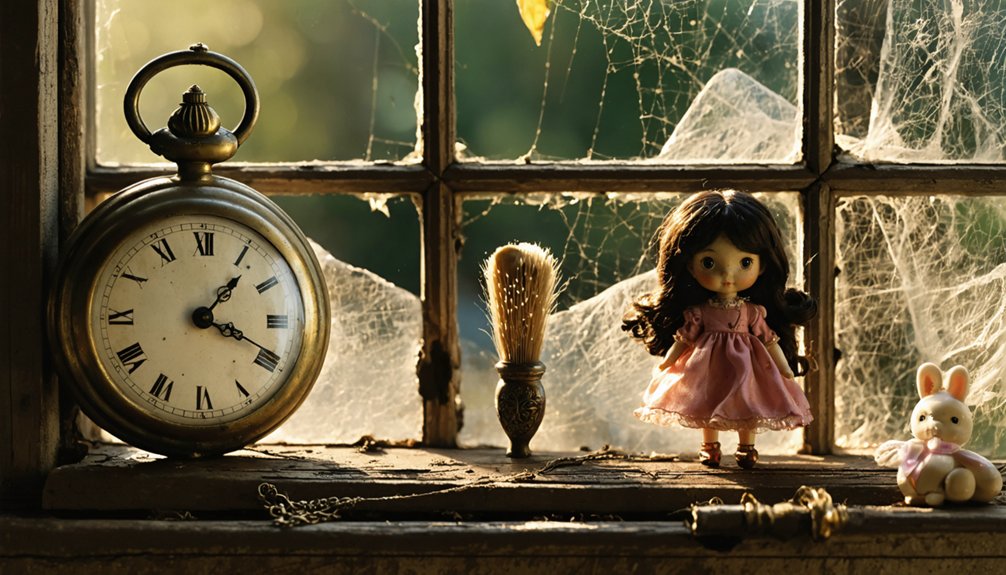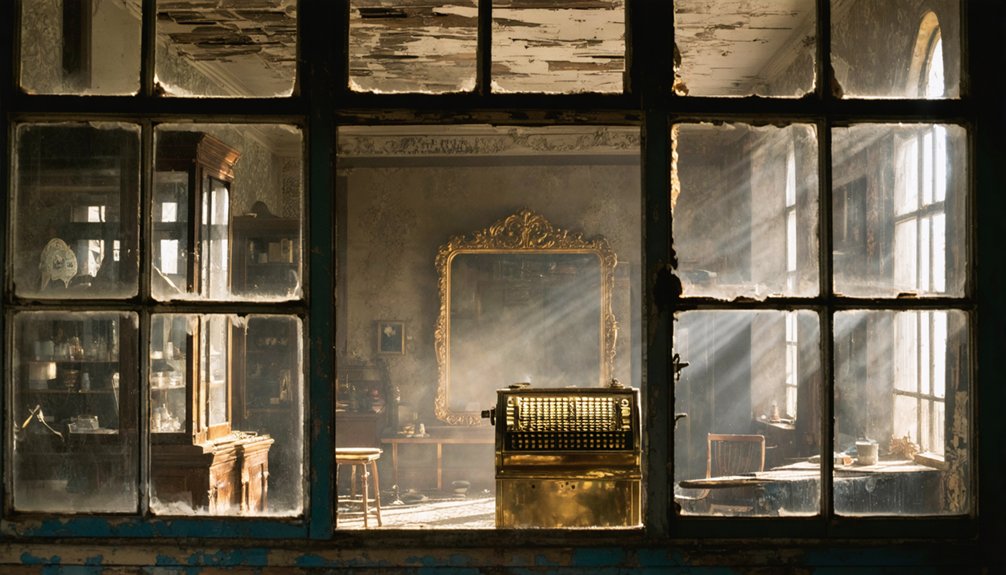You’ll find America’s finest Victorian ghost town artifacts in three remarkable collections. Bodie’s “arrested decay” mining equipment in California showcases authentic 19th-century industrial innovation at 8,379 feet elevation. Colorado’s St. Elmo’s General Store, established circa 1888, preserves period furnishings and mining paraphernalia behind its distinctive clapboard exterior. Nevada’s Mackay Mansion displays Comstock Lode silver rush opulence, including an original sample cabinet and gold-plated chandelier. These preservation sites offer unparalleled insights into frontier mining heritage.
Key Takeaways
- Bodie’s Standard Mill contains original stamp mills and ore processors that extracted over $18 million in gold during the Victorian era.
- St. Elmo’s General Store features authentic period furnishings, mining paraphernalia, and domestic artifacts from Colorado’s Victorian mining heyday.
- Mackay Mansion’s silver artifacts include an original sample cabinet and vault with door hinges from Nevada’s wealthy Comstock Lode era.
- The gold-plated chandelier at Mackay Mansion exemplifies the luxurious lifestyle of Victorian-era Silver Kings in Virginia City.
- These preserved ghost town artifacts maintain “arrested decay” to provide authentic glimpses into America’s 19th-century mining communities.
Bodie’s “Arrested Decay” Collection: Mining Equipment Frozen in Time
When you walk through the ghost town of Bodie, California, you’re witnessing a remarkable preservation philosophy known as “arrested decay.”
This carefully maintained approach guarantees that Bodie’s extensive collection of mining equipment and structures remains exactly as it was left when the town was abandoned, neither restored to pristine condition nor allowed to completely deteriorate.
The Standard Mill, built in 1899, showcases Bodie’s artifacts in their authentic context—stamp mills, ore processors, and boilers rust slowly under California’s sun.
You’ll find vintage machinery from Prescott Scott & Co, San Francisco, scattered throughout this industrial archaeological treasure.
The mining machinery that extracted over $18 million in gold stands as evidence of 19th-century innovation. Located at an elevation of 8,379 feet, Bodie offers visitors a unique perspective on historical mining operations in challenging high-altitude conditions. The photographs documenting these historical artifacts are often licensed through stock photo services like iStock to educate wider audiences.
Unlike reconstructed historic sites, Bodie’s true value lies in its unaltered state, allowing you to experience history without modern intervention.
The Untouched Victorian Treasures of St. Elmo’s General Store
Standing as a remarkable tribute to Colorado’s Victorian mining era, St. Elmo’s General Store offers you a pristine glimpse into the commercial hub that once served the town’s thriving mining community. Established around 1888, this Victorian architecture masterpiece with its distinctive clapboard siding and large display windows has survived long past the town’s boom years.
Inside, you’ll discover an authentic collection of period furnishings, mining paraphernalia, and domestic artifacts ranging from utilitarian tools to decorative china. Once managed by Anton and Anna Stark, the store became a central fixture in the town’s transition from mining to tourism-focused economy. Today, it stands as one of the 43 preserved buildings that make St. Elmo a living museum.
The store’s preservation as part of one of America’s best-maintained ghost towns provides unfiltered access to the mining heritage that defined the region. Since its inclusion in the Historic District registry in 1979, the general store continues to function as both a tangible link to Victorian-era mining communities and an educational portal for those seeking America’s untamed frontier history.
Mackay Mansion’s Silver Rush Artifacts in Virginia City
The Mackay Mansion in Virginia City stands as a symbol of the opulent wealth generated during Nevada’s Comstock Lode silver rush, offering a different perspective on Victorian-era artifacts than St. Elmo’s more modest collection.
You’ll find an impressive array of Silver mining artifacts including an original sample cabinet displaying silver-laden rocks from the Comstock Lode itself.
The mansion’s vault, where Gould and Curry mine’s bullion was once stored, features original door hinges and metal plating.
These Mackay artifacts reveal the intersection of domestic luxury and industrial wealth—from the gold-plated chandelier to the mansion’s extraordinary modern conveniences like Virginia City’s first plumbed toilet and a water heater installed in 1874.
Thomas Edison personally installed the electricity, highlighting how mining magnates like Mackay and Hearst transformed raw silver into refined Victorian living.
Visitors can admire the fireplace mantle crafted from English tiger’s oak, which remains one of only four such mantles in the entire United States.
The mansion offers intimate tours showcasing the lavish lifestyle of the Silver Kings while providing visitors with glimpses into Virginia City’s rich history from the 1860s.
Frequently Asked Questions
Are Artifacts Ever Removed for Restoration or Professional Study?
Yes, artifacts undergo removal a million times over for artifact conservation when deterioration threatens their historical significance. You’ll find professionals carefully document and study these items under strict protocols to preserve America’s heritage.
How Are Fragile Paper Documents Preserved in These Harsh Environments?
You’ll find paper preservation relies on archival techniques like acid-free enclosures, controlled temperature/humidity, minimal handling with gloves, and digitization. Conservators often remove documents from harsh environments for specialized treatment.
What Security Measures Protect These Valuable Collections From Theft?
While you might worry about accessibility, you’re protected by multi-layered security technology including attack-resistant display cabinets, wireless sensors on artifacts, high-resolution surveillance, and theft prevention protocols that still preserve your viewing experience.
Can Visitors Purchase Authentic Victorian-Era Artifacts From These Locations?
No, you can’t purchase authentic artifacts due to local regulations protecting historical sites. Instead, you’ll find replica artifacts and reproductions in gift shops supporting preservation efforts.
How Do Historians Authenticate Items Found in These Ghost Towns?
Historians authenticate ghost town items through scientific dating, microscopic analysis, provenance research, and comparison with established collections. You’ll appreciate how they preserve history through careful artifact conservation and documentation verification.
References
- https://www.christywanders.com/2024/08/top-ghost-towns-for-history-buffs.html
- https://en.wikipedia.org/wiki/Wikipedia:WikiProject_Ghost_towns
- https://www.tripadvisor.com/Articles-loOISRppph64-American_ghost_towns.html
- https://www.youtube.com/watch?v=fPqYTIxEM3w
- https://nightofthejack.com/2025/01/23/top-creepy-ghost-towns-in-america/
- https://www.visittheusa.com/experience/5-us-ghost-towns-you-must-see
- https://en.wikipedia.org/wiki/Ghost_town
- https://stephentravels.com/top5/ghost-towns/
- https://noospheregeologic.com/blog/tag/ghost-towns/
- https://www.atlasobscura.com/lists/americas-best-preserved-ghost-towns



